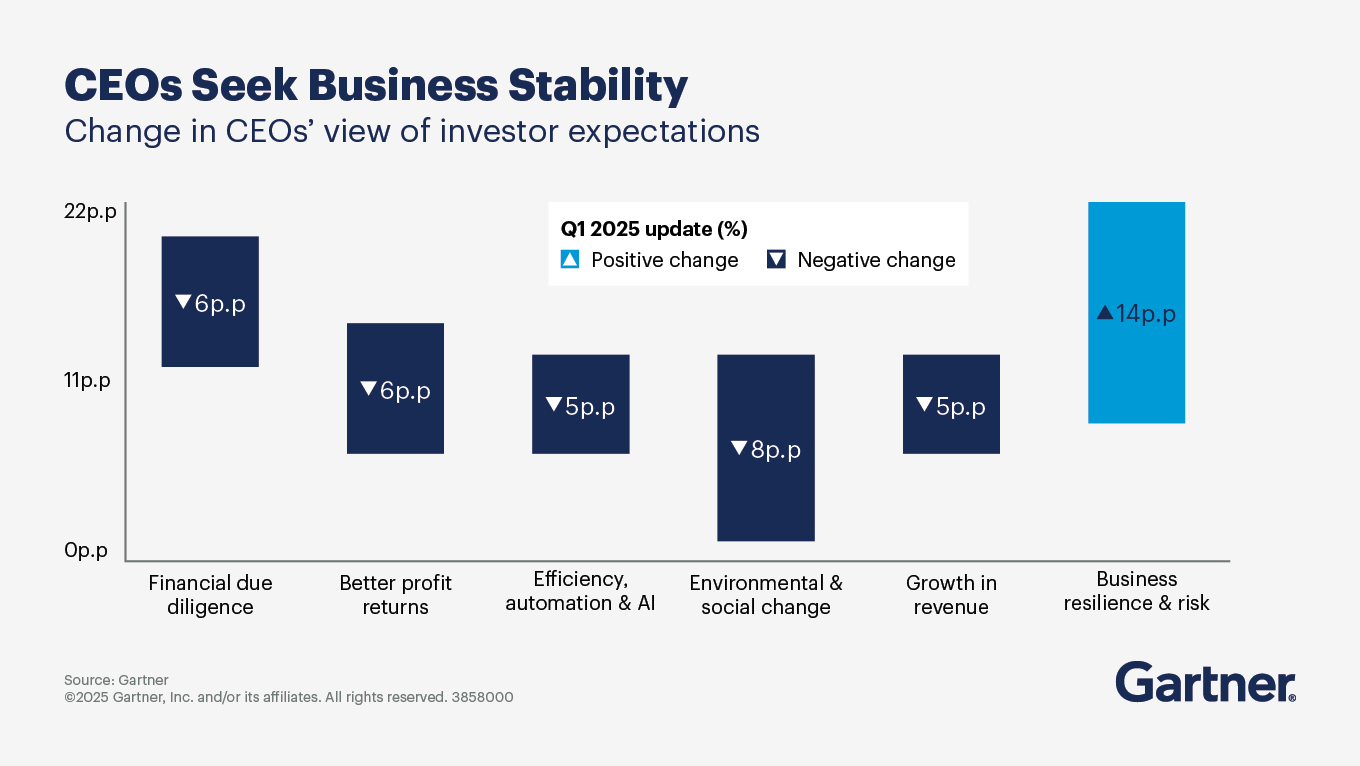Leaders today can’t stick to old playbooks — fast growth, tight budgets and global risks demand smarter, quicker decisions.
- Gartner client? Log in for personalized search results.
2025 is a year of relentless volatility
CEOs are facing a “perfect storm” of market uncertainty, geopolitical risk and rapid technological change. These pressures cascade through organizations, shaping expectations, budgets and strategies at every level. A strategy that looked solid last quarter may now require rapid adjustment.
Staying ahead in this climate requires anticipating where the organization is headed, understanding the data driving top-level decisions and translating shifting priorities into actionable plans.
Growth still matters, but disruption is changing the playbook
While CEOs remain focused on growth, their attention is increasingly split across multiple and competing priorities.
Concern about financial volatility has surged
According to Gartner’s 1H25 CEO survey, 47% of CEOs now cite financial volatility among their top 3 business concerns — a 17% jump from the previous quarter. This is driving a wave of operational changes across the C-suite.
The top 5 actions CEOs are taking to safeguard organizational performance are:
Pursuing cost-efficiency measures (77%)
Adjusting pricing strategies (51%)
Deploying fully automated, robotic and AI systems (48%)
Improving value communication to customers and stakeholders (48%)
Increasing product and service volumes (42%)
For CFOs, COOs and CIOs, this translates to a dual mandate: Drive growth, but do it with relentless attention to cost, automation and operational agility.
The AI paradox: Big bets, shrinking talent investment
AI is at the top of CEOs’ agendas — 79% believe it will have the greatest impact of any technology on their industry in the next three years. Yet, somewhat paradoxically, 18% of CEOs plan to decrease investment in people and culture development, and 31% are reducing hiring.
This creates a real tension. How can organizations deliver on the promise of AI-driven transformation with diminished investment in talent and training? The challenge is to reframe workforce development as a business enabler, not just a cost center, and to ensure that productivity gains from AI are reinvested into building top talent’s future-ready skills.
Risk appetite is down while scenario planning is up
Half of CEOs plan to reduce their risk appetite for 2025 and 2026, thanks in large part to geopolitical risks and uncertain U.S. tariffs. This shift is prompting more incremental, lower-risk moves — such as supply chain redesign and selective market entry — over bold, capital-intensive bets.
For C-suite leaders, this means scenario planning and dynamic strategy cycles are more important than ever. Decentralized decision making, agile planning and close monitoring of geopolitical signals are becoming core competencies for every executive team.
Price increases and customer value: The new balancing act
Nearly half (43%) of CEOs plan to raise prices in response to tariffs and cost pressures, but customers are more price-sensitive than ever. This requires a compelling value proposition that goes beyond price alone.
To meet the moment, leading organizations are investing in dynamic pricing, value communication and developing a deep understanding of the voice of the customer. It’s not just about justifying price increases — it’s about delivering and demonstrating value that customers feel.
A call to reexamine and challenge assumptions
When strategic planning assumptions can change overnight, the real differentiator is the ability to challenge conventional wisdom and adapt with speed. Organizations that succeed in the near term won’t necessarily be the biggest or boldest, but rather those most prepared to turn volatility into opportunity by staying vigilant, regularly updating strategies and building operational resilience.
2025 CEO challenges FAQs
What is the biggest challenge CEOs face in 2025’s volatile environment?
In 2025, CEOs’ top challenge is balancing growth ambitions with the need for cost control and risk management. CEOs must make tough trade-offs as geopolitical instability, rapid technological change and shifting investor expectations create constant pressure to adapt. Success depends on acting with agility, investing in talent and technology and maintaining a clear focus on delivering value to customers.
How can CEOs ensure their organizations stay resilient amid ongoing disruption?
Resilient organizations empower decentralized decision making, invest in both AI and workforce skills and maintain operational flexibility. CEOs should regularly reassess geographic and supply chain strategies, use scenario planning to prepare for shocks and prioritize a strong customer value proposition. Treating talent and culture as core stabilizers helps maintain performance and adaptability through uncertainty.
Attend a Conference
Accelerate growth with Gartner conferences
Gain exclusive insights on the latest trends, receive one-on-one guidance from a Gartner expert, network with a community of your peers and leave ready to tackle your mission-critical priorities.

Drive stronger performance on your mission-critical priorities.
